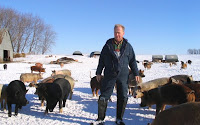 I had recently heard that the founder of Niman Ranch, Bill Niman, had left the company after some financial troubles (had to sell some ownership to keep afloat) and difference on practices with a new group on board. Until yesterday I didn’t know much about the story (either how Niman Ranch begain or Mr. Niman leaving), but thanks to the Practical Farmers of Iowa Listserv I was able to read this article from the San Francisco Chronicle.
I had recently heard that the founder of Niman Ranch, Bill Niman, had left the company after some financial troubles (had to sell some ownership to keep afloat) and difference on practices with a new group on board. Until yesterday I didn’t know much about the story (either how Niman Ranch begain or Mr. Niman leaving), but thanks to the Practical Farmers of Iowa Listserv I was able to read this article from the San Francisco Chronicle.
What was most interesting to me was the story behind the beginnings of Niman Ranch. Basically Mr. Niman was a guy not from the farm (I can kinda relate) that ended up deciding that he could raise high quality food. He initially bought 11 acres and started out with a few animals before grabbing a partner and jumping up to 200 acres and cattle. The beef was really the beginning of Niman Ranch, but all I have ever heard about here in Iowa is the pork side of things. You really should check out the story if you want to know the complete background.
Anyways, it sounds like Mr. Niman was an idealistic kind of guy who didn’t believe in hormones, only partially in antibiotics, and hated the ideas of feedlots. His goal was to raise high quality beef that was great tasting and humanely raised. To that end he set up his own special finishing system (I don’t really know much about this) and Niman Ranch beef had to go through that farm to receive the Niman label. The pork system wasn’t like that…
The Niman Ranch model is an interesting story. I have known a few Niman pork producers and even had some Niman Ranch pork (or what would have been Niman Ranch pork) and I think it has been a very good outlet to farmers that are willing to jump on board with their rules. In fact I have heard quite a few farmers change their farm over from a conventional crate farrowing system to a pen farrowing deal and outdoor raising and really love the change.
Here is the most interesting thing that I got out of this article. There are really a lot of different ways to skin a cat … or be sustainable (depending on your definition of the word). Some would call the Niman model not very sustainable because it still included shipping Iowa pork all the way to California, while others would say that it was very sustainable because it allowed some smaller scale pork producers in Iowa to stay in business and raise pigs in a pretty good way.
The farmers that work for Niman Ranch don’t have to worry about the marketing, but they can still raise pigs without building the latest and greatest steel hog facilities. I like what I have seen from some of the Niman producers … some of them have farms like my grandfather had…


There is an article about a farmer starting out by raising Niman Ranch hogs in a deep-bed system in Successful Farming magazine.
http://www.agriculture.com/ag/story.jhtml?storyid=/templatedata/ag/story/data/1234990244701.xml
From the article, “…he farrows two groups of 16 to 18 sows twice a year, usually finishing about 500 to 600 hogs. He also finishes 20 to 30 head of cattle a year. He’s been raising livestock for about three years…”
Rich – Thanks for the link to that article. Neat article about a guy close to my age just west of us a ways.
I am very interested in how the farmers are treated who are a part of the Niman Ranch. I have seen how Tyson farmers are treated and before I purchase any Niman Ranch meat, I would like to know that they are treated better than Tyson Farmers. Any info would be helpful.
Anonymous …
I hope you find this message! I have actually know farmers who work with Niman Ranch for almost ten years now (much longer than I’ve been farming). And, I would say across the board they have been satisfied with their dealings with NIman Ranch.
Just my two cents …